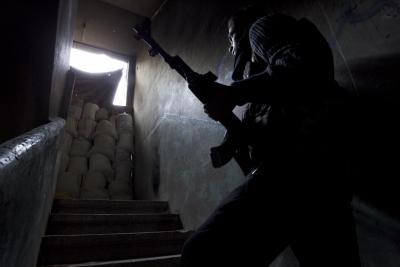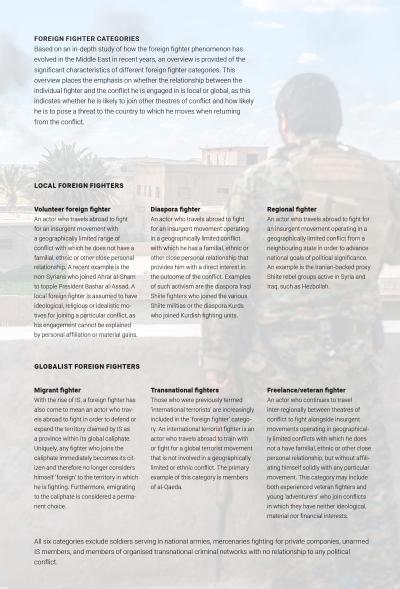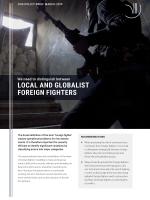Local and globalist foreign fighters

The broad definition of the term ‘foreign fighter’ causes operational problems for risk assessments. It is therefore important for security officials to identify significant variations by classifying actors into major categories.
■Ways should be provided for foreign fighters who have joined local rebel groups to ‘opt out’ and return home after the end of fighting in order to discourage them from becoming globalist foreign fighters and to stem potential flows of foreign fighters to new theatres of conflict.
The unprecedented size and constellation of the wave of foreign fighters travelling to Syria and Iraq has made it difficult for security officials and lawmakers to determine which actors should be covered by the term. Because this phenomenon is continually evolving, the term has been used to describe ever more varied trends, such as the inclusion of female IS members.
In September 2014, the United Nations Security Council adopted the term ‘foreign terrorist fighter’ to describe ‘nationals who travel or attempt to travel to a State other than their States of residence or nationality, and other individuals who travel or attempt to travel from their territories to a State other than their States of residence or nationality, for the purpose of the perpetration, planning, or preparation of, or participation in, terrorist acts, or the providing or receiving of terrorist training, including in connection with armed conflict.’
This definition adds to David Malet’s widely used definition of foreign fighters as ‘non-citizens of conflictstates who join insurgencies during civil conflicts’, as well as Thomas Hegghammer’s description of a foreign fighter as an unpaid agent who has joined a non-state armed group in an insurgency with which he does not have citizenship or any ties of kinship.
Because of the operational problems caused by the wide variation in the use of the term, it is important to identify significant variations by classifying actors into major categories. This overview of relevant categories has been developed with an emphasis on whether the foreign fighters’ engagement in conflict is local or globalist, rather than on their affiliation or lack of affiliation with terrorism.

Recommended distinctions
The lack of an accepted legal definition of terrorism creates an operational ambiguity in assessing the risk profiles of foreign fighters involved in terrorism, as distinct from foreign fighters involved in activities that are in fact legal in armed conflicts, such as armed resistance to foreign occupation or to genocide. Accordingly, I recommend focusing on the distinction between local and globalist foreign fighters rather than that between terrorists and non-terrorists.
Most importantly, foreign fighters who join armed groups with global aims will have notably different risk profiles from those who join rebel groups with local aims. Foreign terrorist fighters with globalist aims are more likely to find other theatres of war relevant or to include attacks on the West in their strategy. Furthermore, their ability to ‘opt out’ is complicated by their potential criminalisation.
There is an ambiguity between foreign fighters involved in terrorism and those involved in activities that are in fact legal in armed conflicts.
In contrast, diaspora actors are less likely to continue to other theatres of conflict with which they have no direct links, while regional fighters are more likely to limit any further travel to other neighbouring countries involved in the same regional competition for influence. Local foreign fighters are more likely either to settle and stay long term in the area they travelled to after fighting has ended, or to return non-violently to the country from which they travelled.
However, as has been noted, if it is made complicated for local foreign fighters to return after fighting has ended, they may develop a more global focus and continue to travel between different theatres of conflict. The categories presented are therefore dynamic in nature, as actors may move between them in response to the obstacles and opportunities they are confronted with. The home states of foreign fighters should therefore contribute to halting global jihadist conflicts by developing avenues for their citizens to return home and national strategies for the rehabilitation of former foreign fighters.
DIIS Experts


